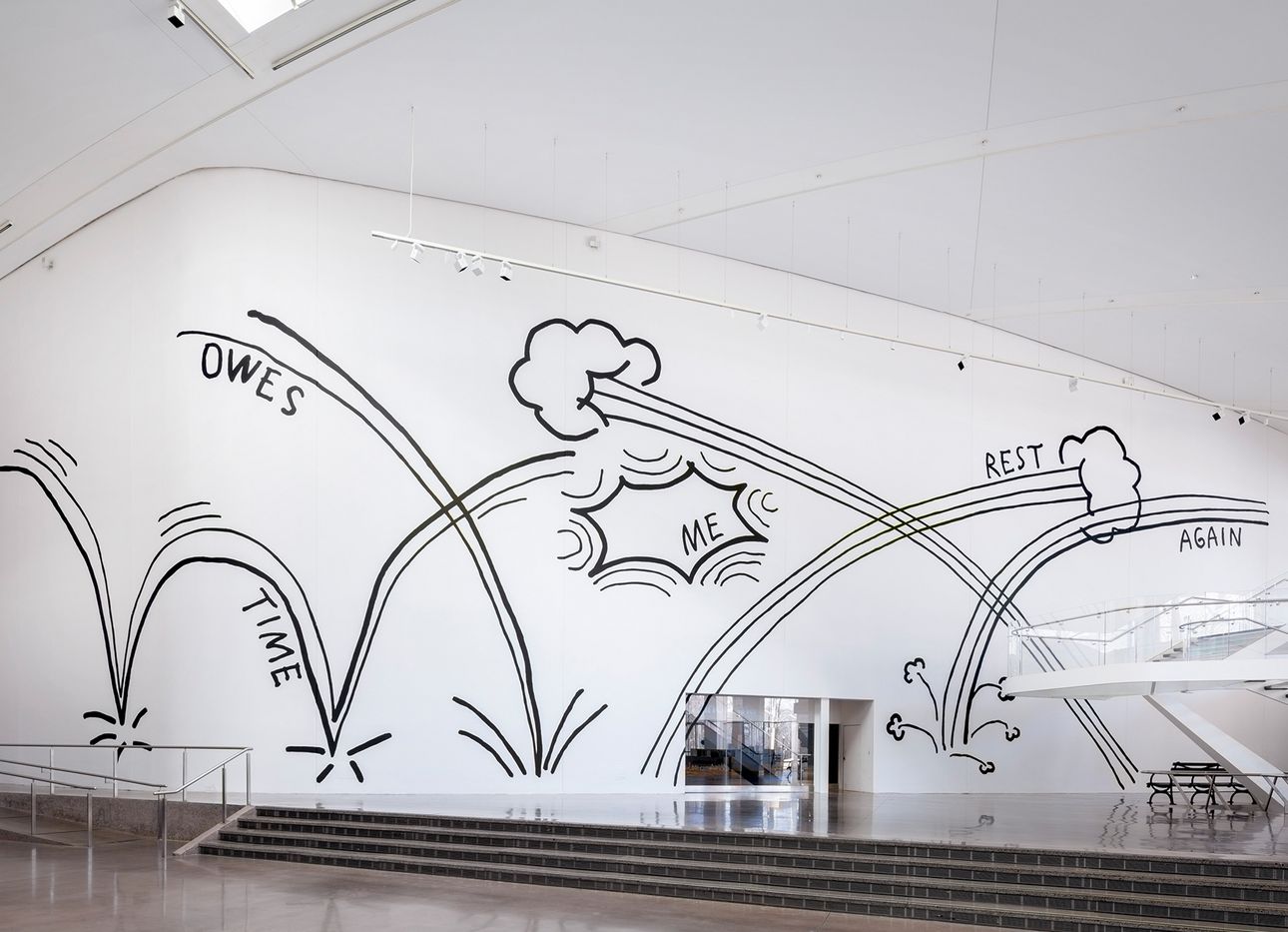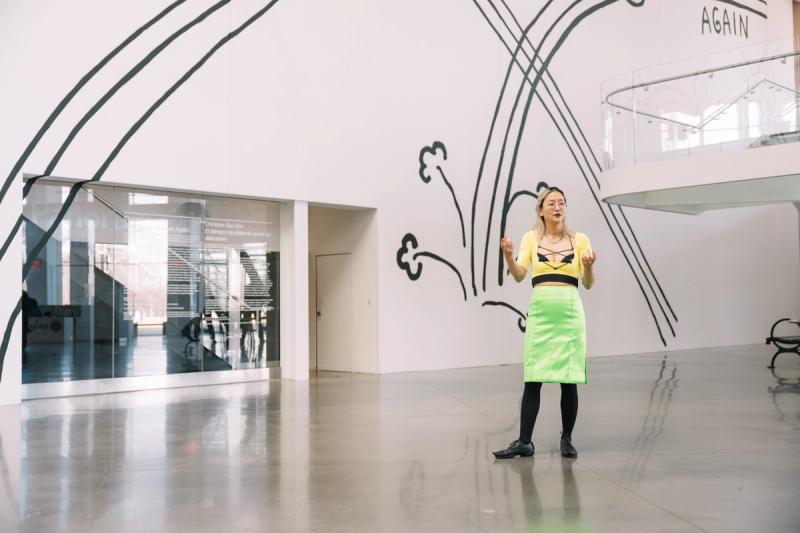
A Sound Artist Exposes the Complex Relationship Between Deaf and Hearing Cultures
At first glance, the term “deaf sound artist” might seem an oxymoron. The Berlin-based, Korean-American artist Christine Sun Kim wants to uproot that assumption. Over the past decade, Kim has created a multidisciplinary body of work that investigates the complex, and often confrontational, relationship between Deaf culture and hearing culture. Her 2013 performance “Face Opera II,” for example, features an all-deaf cast but no signing, upending the expectations of hearing viewers. For her recent project “Captioning the City,” Kim installed large-scale descriptions of various noises across Manchester, England, urging viewers to reconsider how sound is experienced in an urban space. Across disciplines, Kim has sought to expand our understanding of both sound and communication, and to make visible the often overlooked labor that deaf people undertake to engage with the hearing.
Currently, her work can be seen in New York at the Queens Museum, where her large scale, site-responsive mural “Time Owes Me Rest Again” is on view (through Jan. 23, 2023). We spoke with Hitomi Iwasaki, the exhibition’s curator, about the inspiration behind the piece, what she hopes visitors take away from it, and how working with Kim has influenced the way she approaches her role.

What was your first experience of Kim’s work?
I was introduced to it in 2012 or 2013—a long time ago—by [Tom Finkelpearl], the director of the Queens Museum back then. He’d attended one of her performance events, where she had a number of iPads placed on stage, displayed to the viewers, and she would walk and swipe through them to spell out certain words in order to communicate, demonstrating how deaf people proactively improvise ways of communication, which can amplify or give another dimension to the limited, “ordinary” spoken communication that hearing people know. I thought, That’s so cool!
I learned more about her work, and we started to talk about what kind of presentation of her practice would be most meaningful for her and for our audience. Then she moved to Berlin for a residency, and never came back. So we shelved the project, but we’d check in with each other on and off. It was not until last year that we connected on this project. She loved the idea of this big mural.
The mural is described as “site-responsive.” Can you share a bit about the process of working with Kim to create the work? How does it reflect its context?
I’m the kind of curator who likes to develop a project together with an artist. “Site-specificity” or “site-responsiveness” can mean many different things. It could be something about the history of this building, or its location in Queens. It could reference the World’s Fair, or cultural diversity, or the globalization of language, culture, and people through immigration. In Christine’s case, her practice is not research-based. She’s got ideas in her already. It’s a matter of adaptation. I said to her, “Do whatever you think would linger.”
I explained to her that we were right in the thick of the pandemic. Here in Corona, Queens, in the early period of the pandemic, it was really hard. I’m sure you remember the news coverage of the refrigerated morgue trucks outside of Elmhurst Hospital. The pandemic is, of course, still ongoing, but it was much more acute back then, especially in this neighborhood. Corona was the hardest hit because it has so many people who are immigrants, many undocumented. Their living conditions are often crowded, and when they would come home feeling sick, there was no way to isolate. The communities were suffering more for not being able to process the loss properly. I explained that to Christine, and she decided the five words of this piece would reference the five boroughs of New York—the walls that house this mural encase the famous Panorama of the City of New York.
“Time Owes Me Rest Again” has a dual meaning. One is referencing the ongoing battle against the systemic ignorance and indifference of non-deaf society—about acknowledging and engaging with the hard-of-hearing and Deaf communities in a way that does not marginalize their existence. The piece also references other marginalized groups. This other meaning refers to the facts of Christine herself being a woman and being Asian-American. All of that is part of the consciousness she carries.
Kim is known for gestures that critique the systems of the art world that perpetuate the exclusion of deaf people. How has working on this project with her shifted your professional practices, either personally or institutionally?
I was almost fearful. I knew virtually nothing about Deaf culture. I asked myself, How could I be aware of what I don’t know? How could I expect that I would make mistakes? How could I remain humble and continue to correct myself and have an attitude of learning? One thing I did was I started to learn ASL. It’s not easy! It made me even more timid, in a way, to communicate with Christine. Enrolling in a class of beginner ASL opened up a whole new world of awareness for me, awareness of things beyond Deafness, such as blindness and other physical and mental disabilities. At the Queens Museum, “access” programs have always been part of our practice. There is no doubt that the awareness of different needs has been heightened, and the idea of “accessibility” has been broadened and further incorporated. It takes time, but it is taking place.
What do you hope people take away from encountering this piece?
People love taking selfies in front of Christine’s mural, of course. Even Christine herself took a lot! The piece has an easy access point. It’s friendly with its cartoonish style. It doesn’t look like a Rembrandt in a gilded frame. Many people ask, “Is this art?” I love that openness. I hope a visitor reads “Time Owes Me Rest Again,” and asks themselves, What does this mean? This is done by a deaf artist, and she’s visualizing the language as hand gesture and motion. That motion creates commotion, multiplying and amplifying what language could be. Sign language is not an interpretation tool; it’s a language of its own.
Maybe three out of a hundred people who pass by the piece make it to this point of asking. But if they come into contact with this fact that they didn’t know previously, that’s a success. Her practice makes a little opening that lets us see another way of thinking, and how much you open up that hole is up to you.